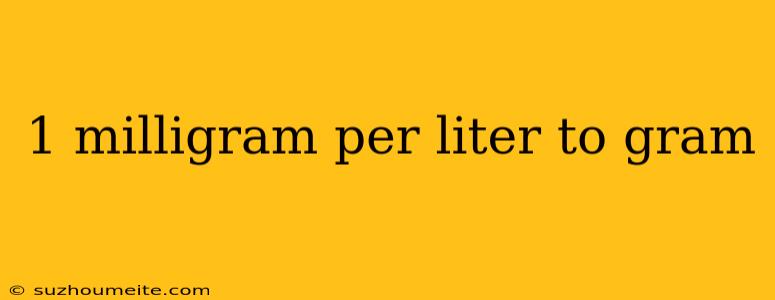1 Milligram per Liter to Gram: A Conversion Guide
When working with measurements in chemistry, physics, and engineering, it's essential to understand the different units of measurement and how to convert between them. One common conversion is from milligrams per liter (mg/L) to grams (g). In this article, we will explore how to make this conversion and provide a step-by-step guide.
What is Milligram per Liter (mg/L)?
Milligram per liter (mg/L) is a unit of measurement that represents the concentration of a substance in a solution. It is defined as one milligram of a substance per liter of solution. This unit is commonly used in chemistry and biology to express the concentration of a solution.
What is Gram (g)?
A gram (g) is a unit of mass in the International System of Units (SI). It is defined as one-thousandth of a kilogram. Grams are commonly used to measure the mass of substances in chemistry, physics, and everyday applications.
Converting Milligram per Liter to Gram
To convert milligrams per liter (mg/L) to grams (g), you need to know the volume of the solution in liters. The conversion factor is as follows:
1 mg/L = 1 mg/1000 mL = 0.001 g/L
Step-by-Step Conversion Guide
- Determine the volume of the solution: Measure or calculate the volume of the solution in liters (L).
- Convert mg/L to g/L: Multiply the concentration in mg/L by the conversion factor (0.001 g/L per mg/L).
- Calculate the mass in grams: Multiply the result from step 2 by the volume of the solution in liters.
Example Conversion
Suppose you have a solution with a concentration of 500 mg/L and a volume of 2 liters. To convert this to grams, follow these steps:
- Volume of the solution: 2 L
- Convert mg/L to g/L: 500 mg/L * 0.001 g/L per mg/L = 0.5 g/L
- Calculate the mass in grams: 0.5 g/L * 2 L = 1 g
Therefore, the mass of the substance in the solution is 1 gram.
Conclusion
Converting milligrams per liter to grams is a straightforward process that requires knowledge of the volume of the solution and the conversion factor. By following the step-by-step guide provided in this article, you can easily convert between these units of measurement.
